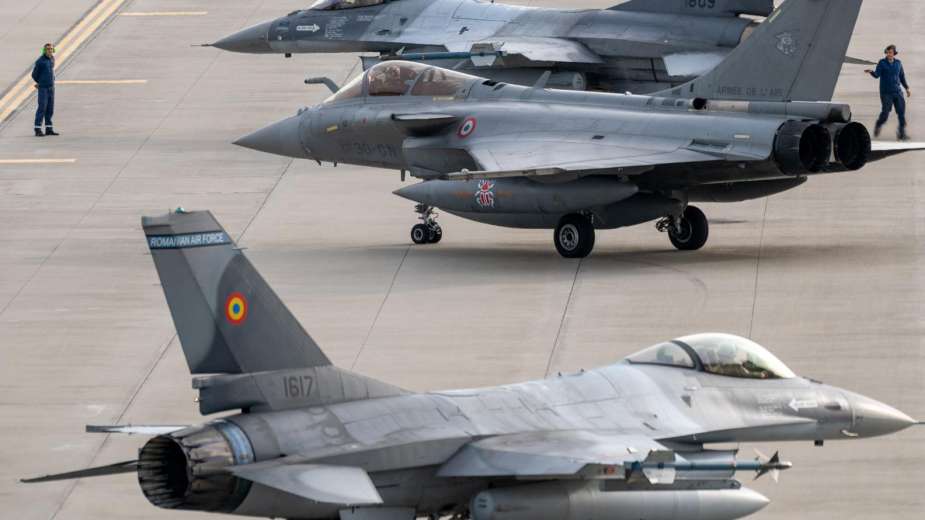Breaking news
France deploys Rafale fighter jets in Romania to reinforce NATO's eastern flank.
Between March 4 and March 9, 2024, three Rafale fighter jets left Air Base 118 in Mont-de-Marsan for Romania, marking a new phase in the military collaboration between France, Belgium, Romania, and Türkiye. This deployment, supported by the transportation of a 33-member aviation team (5 pilots and 28 ground personnel) via an Airbus A400M, underscores NATO's ongoing commitment to strengthening its defensive presence along its eastern flank.
Follow Army Recognition on Google News at this link

French Rafale fighter jet and Romania F-16 multi-role fighter jet in Romania (Picture source: French Ministry of Armed Forces)
During this period, the Rafales conducted 12 sorties, totaling 30 flight hours, involving close air support exercises and joint missions with Turkish and Romanian F-16s. These operations demonstrated exceptional interoperability and coordination between different air forces, essential for achieving NATO's strategic objectives in the region.
The deployment is part of Operation MORANE, integral to NATO's Air Shielding initiative launched in response to the escalation of tensions following Russia's invasion of Ukraine in February 2022. This mission reflects the Alliance's commitment to ensuring credible deterrence and robust defense of its members, especially those located near conflict zones.
The strategic importance of Romania, situated on the Black Sea coast, cannot be underestimated. In May 2022, France initiated Operation Eagle, deploying 500 soldiers to Constanta, supported by a contingent of 300 Belgian and Dutch soldiers, to bolster NATO's Enhanced Forward Presence Battle Groups. The addition of a SAMP/T (MAMBA) ground-to-air defense system by France further enhances NATO's ability to protect its forces and maintain security in the region.
NATO's increased presence, exemplified by deployments such as the Rafales in Romania, serves several objectives. It sends a clear message of solidarity and determination to protect all Alliance members against any form of aggression. Moreover, it enhances the interoperability and combat readiness of NATO forces, key elements for maintaining a strategic advantage in a region marked by increased geopolitical tensions.
The Rafale jets deployed in Romania bring advanced technological capabilities and significant operational flexibility to the NATO mission, aimed at strengthening defense and deterrence on its eastern flank. These aircraft, designed to be "omnirole," can perform a wide range of missions with a minimum of assets. Their versatility enables them to conduct air policing, territorial security, nuclear deterrence, force projection and power operations for external operations, close air support for ground troops, and much more.
The Rafale is distinguished by several key technical features that make it particularly suited to these missions. It is equipped with a delta wing and canards for optimal maneuverability and flight performance, including at high angles of attack. Digital fly-by-wire flight control systems offer quadruple redundancy, ensuring exceptional safety and stability, even under difficult flight conditions. This feature allows the Rafale to automatically follow terrain without visibility, thereby improving its penetration capability and survivability in enemy airspace.
The M88-2 engine by Safran Aircraft Engines, compact and powerful, provides significant maximum thrust, with cutting-edge technologies that enhance durability and reduce operating costs. Thanks to its advanced design, the Rafale achieves a maximum speed of over Mach 1.8, a supercruise capability at Mach 1.4, and can operate up to an altitude of 50,000 feet. With a configured air-to-air mission range of 1,093 miles and the possibility of endurance up to 12 hours with aerial refueling, the Rafale is capable of executing extended missions over vast geographical areas.
Its design incorporating passive and active stealth elements, combined with a wide range of sensors and multi-sensor data fusion capability, allows the Rafale to collect and share critical information in real-time, increasing the combat group's efficiency and interoperability with other allied forces. These capabilities are essential for maintaining a tactical advantage in modern operations, where superiority in information gathering and reaction speed are key.
Therefore, the deployment of Rafales in Romania significantly strengthens NATO's defensive posture in the region, enhancing its ability to monitor, deter, and if necessary, respond quickly and effectively against any threat.

























